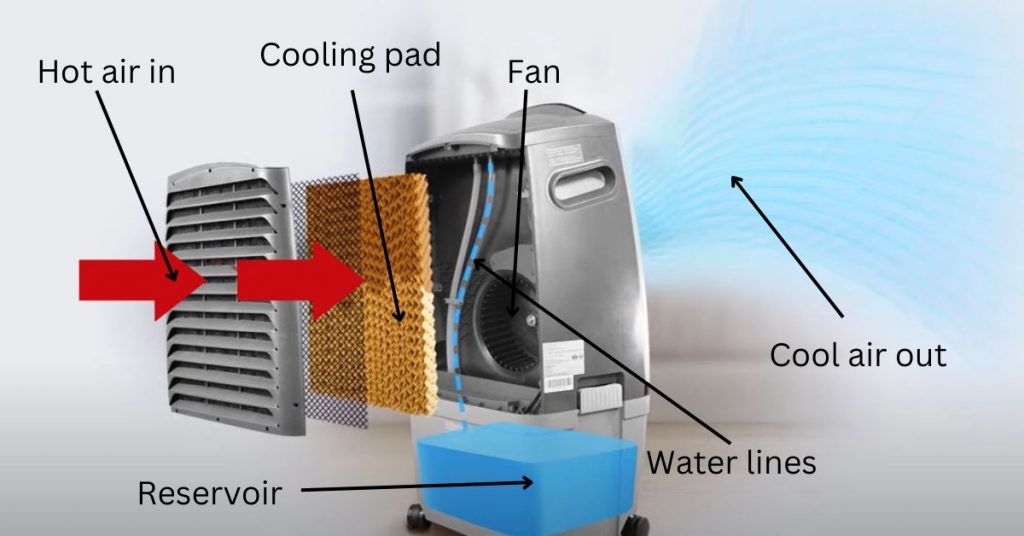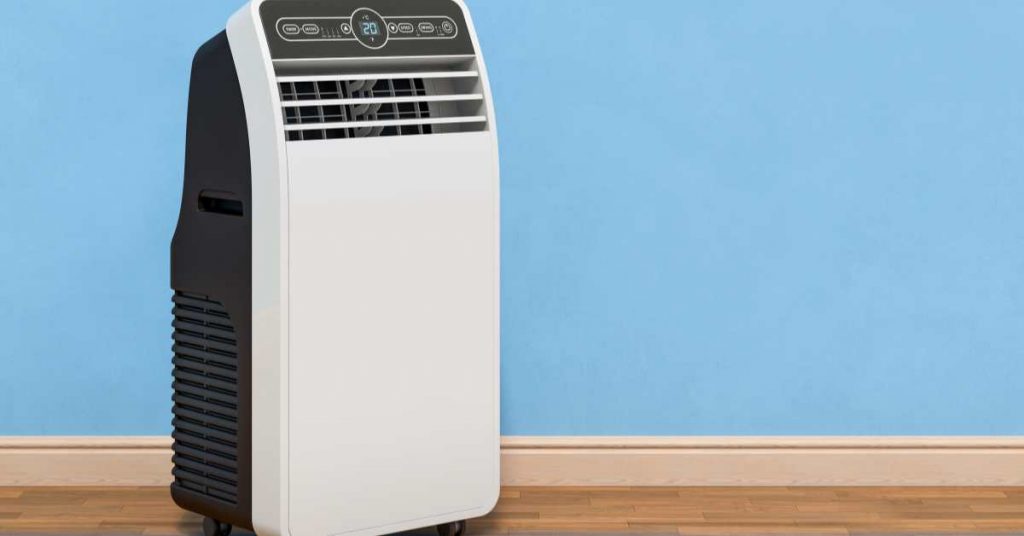
Swamp coolers and air conditioners are two distinct methods for cooling indoor spaces, each with its own advantages and limitations. Here’s a summary of the key differences between swamp coolers (evaporative coolers) and traditional air conditioners:
Swamp Coolers (Evaporative Coolers)
- Operating Principle: Swamp coolers use the natural process of evaporative cooling. They draw warm air through water-saturated pads, where it is cooled by evaporation before being circulated into the living space.
- Energy Efficiency: Swamp coolers are highly energy-efficient and consume significantly less electricity than traditional air conditioners, making them a cost-effective cooling option.
- Environmental Impact: These systems are eco-friendly, as they do not use refrigerants or produce greenhouse gases. They rely on water as their primary cooling medium.
- Humidification: Swamp coolers add moisture to the air, which can be beneficial in dry climates but may not be suitable for humid regions.
- Effective in Dry Climates: Swamp coolers work best in arid or dry climates with low humidity levels. They may not be as effective in humid conditions.
- Maintenance: Regular maintenance, including cleaning and replacing pads, is necessary to prevent mold and mineral buildup.
Traditional Air Conditioners
- Operating Principle: Air conditioners use a refrigeration cycle to remove heat from indoor air. They circulate a refrigerant between indoor and outdoor units to cool and dehumidify the air.
- Cooling Efficiency: Air conditioners are highly effective at lowering indoor temperatures and can provide precise climate control regardless of outdoor humidity levels.
- Dehumidification: Air conditioners naturally dehumidify the air as they cool it, making them suitable for reducing indoor humidity levels.
- Environmental Impact: Traditional air conditioners use refrigerants that can have a negative environmental impact if not properly managed. Newer models use more environmentally friendly refrigerants.
- Energy Consumption: Air conditioners typically consume more electricity than swamp coolers, resulting in higher energy bills.
- Suitable for Various Climates: Air conditioners are effective in a wide range of climates, making them a versatile cooling option.
Here’s a table highlighting the key differences between swamp coolers (evaporative coolers) and air conditioners:
| Aspect | Swamp Coolers (Evaporative Coolers) | Air Conditioners |
|---|---|---|
| Cooling Method | Uses water evaporation to cool the air | Uses refrigeration to cool the air |
| Energy Efficiency | Typically more energy-efficient and consume less electricity | Generally less energy-efficient and consume more electricity |
| Humidity Impact | Increases humidity levels in the air | Lowers humidity levels in the air |
| Cooling Effectiveness | Most effective in dry climates with low humidity | Effective in various climates and humidity levels |
| Installation | Easier and less expensive to install | More complex installation process and may require professional help |
| Maintenance | Regular cleaning of water pads and occasional pump maintenance | Regular cleaning of filters and periodic maintenance |
| Ventilation | Provides natural ventilation and fresh air intake | Recirculates indoor air without introducing fresh air |
| Operating Cost | Lower operating costs due to lower energy consumption | Higher operating costs due to higher energy consumption |
| Environmental Impact | Relies on natural processes and uses less refrigerant | Uses refrigerants, which can have environmental impact |
| Allergen Control | Provides minimal filtration of airborne allergens | Can include advanced filtration systems to remove allergens |
To really understand the difference between swamp coolers and air conditioners, let us look at how each of them work.
How Swamp Coolers Work
As I mentioned, swamp coolers cool air using water. Water being a natural coolant will readily absorb heat from air and that it why it feel cools just by being closer to a water body like a waterfall or river.
When water evaporates, it takes heat from the surrounding with it. Our bodies use this technique to cool themselves through sweating. As the sweat evaporates, it absorbs heat leaving behind a cooling effect.
Swamp coolers work by drawing warm air from the house and forcing it through a moistened pad. As the air moves through the pad, water absorbs heat from it and evaporates. The cooled air is then cycled back to the house using a fan.

Swamp coolers are made of the following parts:
- Cooling pads
- Water reservoir
- Water lines
- Pump
- Float
- Fan/blower
The reservoir is located at the bottom of the unit. It is connected to the water supply system using water distribution lines.
When the evaporative cooler is turned on, the first thing that happens is filling the reservoir with water. The level of water in the reservoir is controlled by a float, similar to that inside a toilet tank.
When the water level in the tank is where it is needed, the float turns the water valve off. And when the water level drops below the required level, the float opens the valve allowing the reservoir to fill.
A water pump draws water from the reservoir and pours it over the cooling pads to keep them moist. After that the fan kicks in and starts pulling warm air from the house.
As the warm air passes through the cooling pads, the moisture in the pads absorb the heat from the air cooling it in the process. As the moisture evaporates, the fan circulates the cooled air throughout the house via the ductwork.
Since these units use water to cool air, it can be a problem if you don’t have access reliable water supply. The pump will continuously spray the pads with water so you need to ensure that you have constant supply of water.
You can however use a swamp cooler in “vent only mode” usually when the temperature is not too high. When this mode is activated, the pump will not supply the cooling pads with water and it will therefore work like a whole-house fan.
Two-Stage Swamp Coolers
Usually, swamp coolers struggle when air temperatures are 100 degrees Fahrenheit and higher. And that is why there are modern evaporative coolers to deal with that problem.
Two-stage swamp coolers cool the air directly and indirectly. As a result, they are more effective than single-stage swamp coolers and will also release less humidity to the air.
The first stage is the indirect cooling. Here, the air from the house is passed through an air-water heat exchanger, where cold circulation water absorbs heat from the air. The exchanger lowers the air’s temperature significantly without increasing its humidity.
From the indirect cooling the air then flows to the direct cooling stage which is in essence evaporative cooling. It is forced through a cooling pad where it loses more heat to the water in the pad.
Two-stage swamp coolers are therefore able to provide better cooling while not increasing indoor humidity by much.
How Air Conditioners Work
Air conditioners use a refrigerant/coolant/Freon to cool air. Ideally, the refrigerant is a chemical with a low boiling point and high latent of heat of vaporization.
There are many types of air conditioners but they all work the same way. Typically, an air conditioner will have the following parts:
- Evaporator coil
- Condenser coil
- Compressor
- Expansion valve
The 4 parts are connected together using copper pipes forming a closed loop through which the refrigerant circulates. Apart from portable ACs, air conditioners have an indoor unit and outside unit.
The inside unit is where the refrigerant absorbs heat from the indoor air while the outside unit is where the refrigerant releases the heat to the outside air. Portable ACs need to be vented in order to release the heat to the outdoors.

Cooling happens when warm air from the indoors is forced across the evaporator coil, which contains a cold refrigerant. The refrigerant absorbs heat from air and the fan circulates cooled air back to the house.
Apart from cooling the air, the evaporator coils also dehumidifiers the air. Moisture in the air condenses upon contact with the cold coil and is drained out.
After absorbing heat from indoor air, the refrigerant evaporates and flows out to the compressor, taking the heat with it. The compressor compresses it, increasing its pressure and temperature allowing it to lose the heat at the condenser coil.
Differences Between Swamp Coolers and Air Conditioners, Pros and Cons
The following are the main differences between air conditioners and swamp/evaporative coolers:
1. Mode of Cooling
As we have seen from the above explanation, swamp coolers use water to cool air while air conditioners use a chemical refrigerant like Freon.
The refrigerant flows in a closed loop where it changes from liquid to gas and back to liquid again and does not need to be recharged. On the other hand, the water in swamp coolers once evaporated cannot be reused and the unit will need more water from your water supply.
2. Cooling Effectiveness
So, do swamp coolers cool as good as air conditioners? The answer is no. Swamp coolers lower the air temperature by about 20 degrees (sometimes as high as 30 degrees but sometimes as low as 5 degrees). Swamp coolers don’t cool the air well when temperatures are higher than 95 degrees.
On the other hand, air conditioners offer a more precise temperature control. You can easily achieve whatever indoor temperature you need with an air conditioner. This is one of their biggest advantage.
3. Where to Install them
Perhaps the main disadvantage of swamp coolers is that they cannot be used everywhere. Since this units increase the relative humidity of the air, they can only be used in hot and dry climates.
In United States, the South Western states like Arizona and Nevada are a good choice. The average humidity in Arizona for instance is 38.5% while the ideal indoor humidity is 30-50%. Increasing the relative humidity in a house in Arizona will therefore not be a concern.

Compare that with Florida which has an average relative humidity of 74.5%. That humidity is already too high. Increasing it will make the air too muggy which also encourages the growth of mold.
4. Ventilation
You need to open a window when using a swamp cooler. The window brings in fresh and dry air while also allowing the humid air from the unit to exit.
Failing to open a window will result in humidity building up in the house. The best windows to open are the ones on the leeward side of the house. However, don’t open the windows too wide as they will allow in excess dry air.
If you can’t open a window for one reason or another, you are advised to install up-ducts through the ceiling.
5. Energy Efficiency
This is the main advantage of swamp coolers over air conditioners. Swamp coolers use the natural evaporation process which makes them very energy efficient
The most energy-efficient swamp coolers use up to 10% of the total energy used by air conditioners while the least energy-efficient swamp coolers use about 35% of the electricity used by air conditioners.
While swamp coolers are more energy-efficient than air conditioners they use water every day, which is an additional cost. On average, swamp coolers use 5 to 15 gallons of water in a day.
6. Effects on Relative Humidity
Relative humidity is described as the amount of water vapor in the air, expressed as a percentage of the total amount of water that the air can hold at that temperature. Swamp coolers increase the relative humidity of the surrounding air while air conditioners reduce the relative humidity of the air.
Apart from cooling the air, air conditioners also act as dehumidifiers. Moisture in the air condenses on the surface of the evaporator coil and is drained outside the house. An air conditioner can remove 5 to 20 gallons of water from the air.
On the other hand, swamp coolers cool the indoor air but also act as humidifiers. All the water evaporated from the cooling pad ends up saturating the indoor air.
7. Cost
In general, it costs less to buy a swamp cooler compared to an air conditioner. Since there are different types of air conditioners, in this case I am referring to central air conditioners and ducted swamp coolers.
It is also cheaper to buy a portable swamp cooler than a potable air conditioner. Portable swamp coolers don’t need to be vented which makes them more portable than portable ACs and since they don’t have the vent going out of the window, they look nicer than ACs.
On average, it costs between $2500 and $7000 to install a central air conditioner. On the other hand, the cost of installing a swamp cooler is between $1500 and $3700.
Perhaps you shouldn’t make your choice of preferred unit based on cost. That is because air conditioners typically lasts longer compared to swamp coolers.
The fact that swamp coolers usually come with a 5-year warranty while air conditioners have a warranty of 10 years or more should tell you which unit is expected to last long.
8. Outdoor Usage
Swamp coolers can be used indoors and outdoors while air conditioners can only be used indoors. Even opening a window when an air conditioner is running can greatly lower its efficiency and that is why these units should only be use indoors.
On the other hand, swamp coolers work well when there is a window opened in the house. If you therefore have an outdoor areas that you would want to cool, you should consider a portable swamp cooler.
The good thing is that swamp coolers can be used outdoors in both dry and humid climates.
9. Effects on Environment
Refrigerant leaks causes depletion of the ozone layer which results in global warming. In fact, it was discovered that Freon’s global warming potential is 2000 times that of carbon dioxide.
Although Freon has been phased out already (though some ACs still use it), there is no proof that the newer refrigerants are safe for the environment.
On the other hand, swamp coolers do not affect the environment in any way. The only thing they can leak is water.
10. Maintenance
Although it is cheaper to install swamp coolers, it is important to note that they require regular maintenance in order to continue working properly. Water can deposit sediments in the system which needs to be cleaned out and also change the cooling pads.
Apart from that, swamp coolers need regular and thorough cleaning to prevent growth of mold.
Air conditioners once installed don’t need to be checked every month. Apart from changing the air filter every 3 months, air conditioners will only need annual maintenance unless something happens before the service date.
Ventless Portable Air Conditioners

As I mentioned, air conditioners need to remove the heat absorbed by the refrigerant outdoors. Since portable ACs don’t have an outside unit, they are usually vented out through the window.
Even in instances when portable air conditioners cannot be vented out through the window, there are other ways to vent them like through the wall, door or ceiling. So, what then are ventless portable air conditioners?
Believe it or not, ventless portable air conditioners are in fact swamp/evaporative coolers. Since they look like portable air conditioners but without a vent, most folks just opt to call them ventless portable air conditioners.
Portable air conditioners can be used without a vent but only in the “dehumidifier” mode. In that mode, the units don’t cool the air but reduce humidity which can actually make the air feel cooler as I explained in this post.
Wrap Up
And basically that is everything about the differences, pros and cons of swamp coolers and air conditioners. I hope that by now you know which cooling system to install in your house.
